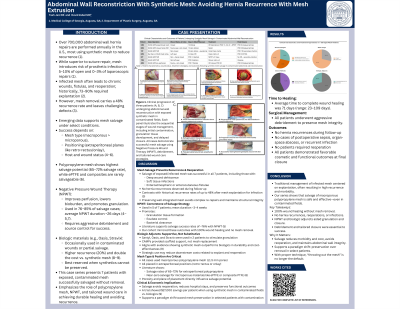Case Series/Study
(CS-068) Salvaging Exposed Lightweight Polypropylene Mesh in Complex Ventral Hernia Repairs: A Case Series of Advanced Wound Care Techniques

Hernia repair remains one of the most common surgical procedures in the United States, with over 700,000 cases annually utilizing mesh. Complex and multiply recurrent ventral hernias, while comprising a smaller proportion of these cases, are challenging due to their high complication rates. Wound dehiscence leading to exposed hernia mesh is a significant concern, traditionally managed through mesh removal. This approach often subjects patients to prolonged recovery, increased recurrence, and greater morbidity. Advancements in wound care now offer alternatives that emphasize the salvage of exposed hernia mesh. Understanding the material composition, porosity, and mesh behavior in wound environments is critical for guiding decisions. This case series highlights a novel, successful approach to managing exposed ventral hernia mesh without removal, emphasizing wound care in optimizing patient outcomes.
Methods:
We prospectively reviewed a single surgeon's database of 900 complex abdominal wall reconstruction patients for mesh extrusion and identified 7 patients with exposed hernia mesh. Patient and outcome data were performed. All patients had lightweight large-pore (3 mm) polypropylene mesh. Mesh was placed in either the retro-rectus plane or the on-lay position. Two patients had mesh contaminated with succus from entero-atmospheric fistulas. Treatment regimens included a combination of standard and advanced wound care techniques to address both contamination and wound healing, tailored to individual patient needs.
Results:
All patients achieved complete wound healing within a mean of 71 days. Aggressive debridement removed necrotic tissue while preserving mesh integrity. NPWT and CAMPs promoted granulation tissue formation through mesh pores, facilitating healing even in contaminated cases. Delayed primary closure was performed when feasible, improving functional and aesthetic outcomes. Notably, no mesh was removed, and no hernia recurrences were observed during follow-up.
Discussion:
Traditional surgical teaching advocates mesh removal in cases of exposure or contamination. However, this series demonstrates that lightweight large-pore polypropylene mesh can be effectively salvaged with mechanical and enzymatic debridement, NPWT, and CAMPs. These findings challenge conventional paradigms, offering a viable alternative to minimize surgical morbidity while achieving successful wound healing. Further studies with larger cohorts are needed to validate findings, refine protocols, and assess long-term durability in complex abdominal wall reconstruction.

.jpg)